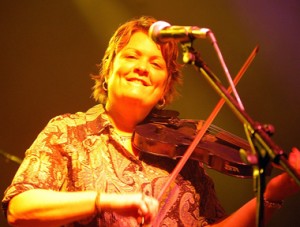Premier Irish fiddler Eileen Ivers has released a stunning new album, “Scatter the Light.” We recently spoke with her about the album, the uplifting messages behind each of the tracks, and the uncanny timing of the album’s hopeful, empowering outlook.
Irish Philly: So what inspired you to compose this new album, Scattered the Light?
Eileen: Sort of various things. It came slowly, as an extension I think of even the last record I did, which was called “Beyond the Bog Road,” which really looked at Irish music and its journey, interacting with other roots elements and really forming the roots of Americana music and bluegrass and French Canadian. So it was a very in-depth record. And then after the record came out and all the research and just the touring with that, I started writing more in a certain vein and realized it was all sort of connected with this very upbeat, positive attitude. And I think also coming out of our joyful Christmas shows, I noticed that there was a wonderful sentiment that was happening when those shows would occur, which I loved. And I remember thinking to myself, why can’t this be carried through the year? This feeling of optimism and joy and really looking for those moments? And that’s when the penny dropped, so to speak.
And I felt, you know what, this is a way to connect the dots. And anytime I do a CD, I think I maybe sometimes overthink it because it does take me a little while between projects, but I think it’s such a major statement when you do release a brand-new piece of work like this because it doesn’t come lightly. And I really try to be very thoughtful about it. In short, it really was all of these tracks linking together in a very thematic way, which made sense, which made a statement. And therefore I did call it “Scatter the Light.”
Irish Philly: Well it’s funny that you should mention overthinking it. Because it didn’t come across that way. It really came across as more from the heart than from the head is if there was no conscious decision-making behind it at all, except that you’re going from your soul and your heart.
Eileen: Thank you. No, it’s funny, it really was happening in that way. But when you start to look at a collection of tunes in the body of work, then you, it’s funny, I realized, wow, there is this theme that ran through it, which is the thoughtful part I think of it. But the knee jerk reaction was interesting where I was just writing these tunes. It started with “Shine,” which is the lead track. And also feeling like I wanted those two gospely, faith-filled songs as part of this. And then these tunes just kept coming. “Road Trip.” very quickly. “Hold My Hand” came in a shot. It was literally looking at this picture—and again, heart took over and those words just came right out. And so it is interesting how music does come at different times in people’s lives and thankfully, this did all come and it’s a record I’m super proud of.



